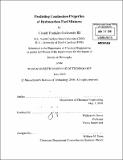Predicting combustion properties of hydrocarbon fuel mixtures
Author(s)
Goldsmith, Claude Franklin, III
DownloadFull printable version (12.48Mb)
Other Contributors
Massachusetts Institute of Technology. Dept. of Chemical Engineering.
Advisor
William H. Green.
Terms of use
Metadata
Show full item recordAbstract
In this thesis, I applied computational quantum chemistry to improve the accuracy of kinetic mechanisms that are used to model combustion chemistry. I performed transition state theory calculations for several reactions that are critical in combustion, including a detailed analysis of the pressure dependence of these rate coefficients. I developed a new method for rapidly estimating the vibrational modes and hindered rotor parameters for molecules. This new method has been implemented in an automatic reaction mechanism generation software, RMG, and has improved the accuracy of the density of states computed in RMG, which in turn has improved RMG's ability to predict the pressure-dependence of rate coefficients for complex reaction networks. I used statistical mechanics to compute the thermochemistry for over 170 of the most important species in combustion. These calculations form a new library of thermodynamic parameters, and this library will improve the accuracy of kinetic models, particularly for fuel lean conditions. I measured reaction rate coefficients using both laser flash-photolysis absorption spectroscopy in a slow-flow reactor and time-of-flight mass spectrometry and laser Schlieren densitometry in a shock tube. Based upon these experimental projects, I helped design a one-of-a-kind instrument for measuring rate coefficients for combustion-relevant reactions. The new reactor combines photoionization time-of-flight mass spectrometry with multi-pass absorption spectroscopy in a laser-flash photolysis cell. The cumulative effect of these efforts should advance our understanding of combustion chemistry and allow us to make more accurate predictions of how hydrocarbons burn.
Description
Thesis (Ph. D.)--Massachusetts Institute of Technology, Dept. of Chemical Engineering, 2010. Cataloged from PDF version of thesis. Includes bibliographical references (p. 189-201).
Date issued
2010Department
Massachusetts Institute of Technology. Department of Chemical EngineeringPublisher
Massachusetts Institute of Technology
Keywords
Chemical Engineering.